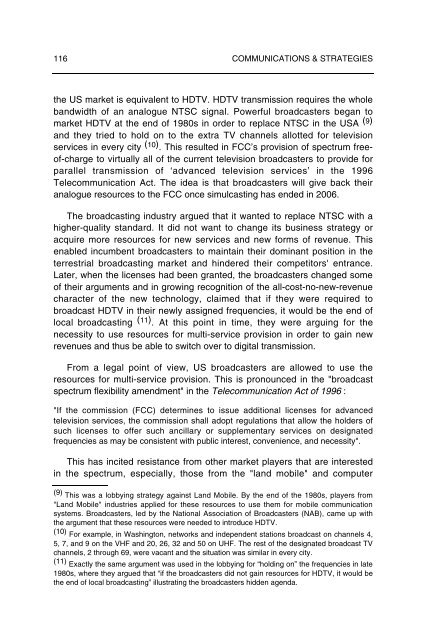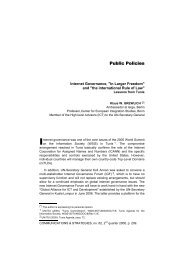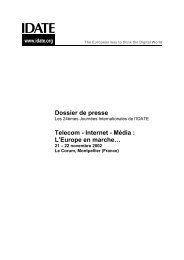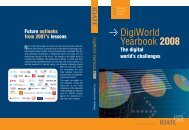Digital Terrestrial Broadcasting: Innovation and Development or a ...
Digital Terrestrial Broadcasting: Innovation and Development or a ...
Digital Terrestrial Broadcasting: Innovation and Development or a ...
Create successful ePaper yourself
Turn your PDF publications into a flip-book with our unique Google optimized e-Paper software.
116 COMMUNICATIONS & STRATEGIESthe US market is equivalent to HDTV. HDTV transmission requires the wholeb<strong>and</strong>width of an analogue NTSC signal. Powerful broadcasters began tomarket HDTV at the end of 1980s in <strong>or</strong>der to replace NTSC in the USA (9)<strong>and</strong> they tried to hold on to the extra TV channels allotted f<strong>or</strong> televisionservices in every city (10) . This resulted in FCC’s provision of spectrum freeof-chargeto virtually all of the current television broadcasters to provide f<strong>or</strong>parallel transmission of ‘advanced television services’ in the 1996Telecommunication Act. The idea is that broadcasters will give back theiranalogue resources to the FCC once simulcasting has ended in 2006.The broadcasting industry argued that it wanted to replace NTSC with ahigher-quality st<strong>and</strong>ard. It did not want to change its business strategy <strong>or</strong>acquire m<strong>or</strong>e resources f<strong>or</strong> new services <strong>and</strong> new f<strong>or</strong>ms of revenue. Thisenabled incumbent broadcasters to maintain their dominant position in theterrestrial broadcasting market <strong>and</strong> hindered their competit<strong>or</strong>s' entrance.Later, when the licenses had been granted, the broadcasters changed someof their arguments <strong>and</strong> in growing recognition of the all-cost-no-new-revenuecharacter of the new technology, claimed that if they were required tobroadcast HDTV in their newly assigned frequencies, it would be the end oflocal broadcasting (11) . At this point in time, they were arguing f<strong>or</strong> thenecessity to use resources f<strong>or</strong> multi-service provision in <strong>or</strong>der to gain newrevenues <strong>and</strong> thus be able to switch over to digital transmission.From a legal point of view, US broadcasters are allowed to use theresources f<strong>or</strong> multi-service provision. This is pronounced in the "broadcastspectrum flexibility amendment" in the Telecommunication Act of 1996 :"If the commission (FCC) determines to issue additional licenses f<strong>or</strong> advancedtelevision services, the commission shall adopt regulations that allow the holders ofsuch licenses to offer such ancillary <strong>or</strong> supplementary services on designatedfrequencies as may be consistent with public interest, convenience, <strong>and</strong> necessity".This has incited resistance from other market players that are interestedin the spectrum, especially, those from the "l<strong>and</strong> mobile" <strong>and</strong> computer(9) This was a lobbying strategy against L<strong>and</strong> Mobile. By the end of the 1980s, players from"L<strong>and</strong> Mobile" industries applied f<strong>or</strong> these resources to use them f<strong>or</strong> mobile communicationsystems. Broadcasters, led by the National Association of Broadcasters (NAB), came up withthe argument that these resources were needed to introduce HDTV.(10) F<strong>or</strong> example, in Washington, netw<strong>or</strong>ks <strong>and</strong> independent stations broadcast on channels 4,5, 7, <strong>and</strong> 9 on the VHF <strong>and</strong> 20, 26, 32 <strong>and</strong> 50 on UHF. The rest of the designated broadcast TVchannels, 2 through 69, were vacant <strong>and</strong> the situation was similar in every city.(11) Exactly the same argument was used in the lobbying f<strong>or</strong> “holding on” the frequencies in late1980s, where they argued that “if the broadcasters did not gain resources f<strong>or</strong> HDTV, it would bethe end of local broadcasting” illustrating the broadcasters hidden agenda.







